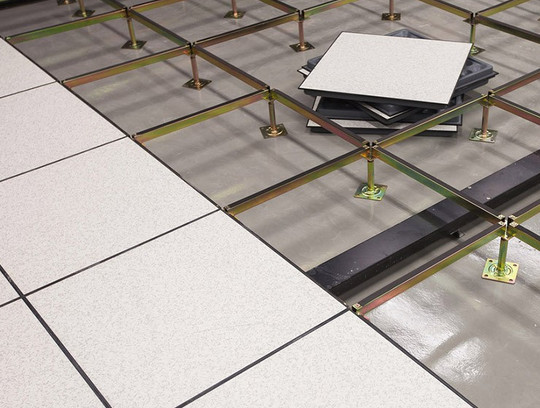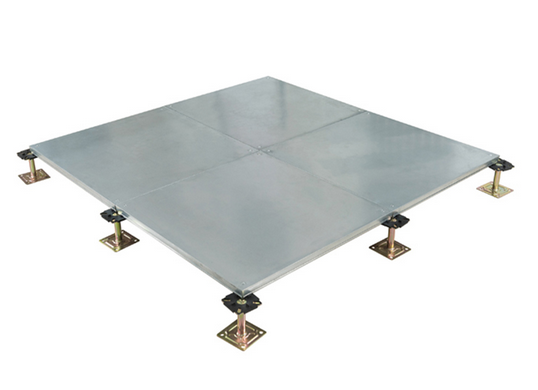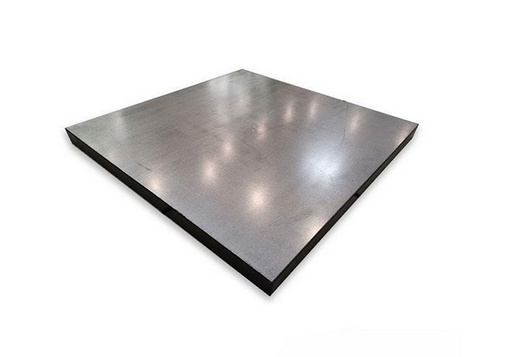Why is the Raised Floor System Gaining Popularity in Modern Construction
 Jul 17, 2023|
Jul 17, 2023| View:304
View:304A raised floor system in building construction refers to an elevated flooring solution that creates a space or void between the structural floor and the finished floor surface. This innovative system is designed to accommodate utilities such as electrical wiring, data cables, HVAC systems, and plumbing within this void. The basic concept revolves around providing a flexible platform that allows easy access to these utilities for maintenance, repairs, and upgrades without causing disruptions to the entire building or infrastructure.

The purpose of using raised floors in building construction is multifaceted. Firstly, they offer a practical solution for managing and organizing cables and wires. By creating a designated space beneath the floor, raised floor systems provide a structured pathway for routing and organizing these utilities, eliminating clutter and reducing the risk of tripping hazards. This streamlined cable management also allows for easier identification and maintenance of specific systems.
Another significant benefit of raised floors lies in their adaptability and flexibility. As technology continues to evolve rapidly, buildings need to keep pace with the ever-changing requirements. Raised floor systems provide a solution by allowing for easy integration of new technologies and infrastructure upgrades. This adaptability future-proofs the building, ensuring that it can efficiently accommodate evolving technology needs without requiring extensive renovations or disruptions.
Raised floors also contribute to improved HVAC distribution and airflow control within a building. The void space beneath the raised floor serves as a controlled pathway for the distribution of heating, ventilation, and air conditioning systems. This promotes efficient cooling throughout the building and maintains a consistent temperature, enhancing the comfort of occupants while optimizing energy usage.
Furthermore, raised floor systems offer aesthetic benefits and design flexibility. The floor surface of a raised floor system can be customized with various finishes, textures, and patterns to align with the overall aesthetic vision of the building. This allows architects and designers to create visually appealing spaces while still enjoying the practical advantages of raised floors.
In summary, the definition and basic concept of raised floor systems revolve around the creation of an elevated flooring solution that accommodates utilities beneath the floor surface. Their purpose lies in providing easy access to utilities, efficient cable management, adaptability to changing technology needs, improved HVAC distribution, and design flexibility. These benefits collectively contribute to enhancing functionality, efficiency, and flexibility in building construction, making raised floor systems an increasingly popular choice in the industry.

Advantages of Raised Floor Systems
Raised floor systems offer enhanced flexibility and adaptability, making them an ideal choice for accommodating changing needs in building environments. The design of raised floors allows for easy reconfiguration and modifications, providing the flexibility required to adapt to evolving layouts or technology requirements. This means that as the needs of a space change over time, such as rearranging office layouts or integrating new equipment, the raised floor system can be easily adjusted to meet these demands without requiring extensive construction or disruptions.
One of the significant benefits of raised floor systems is improved cable management and accessibility for electrical and data systems. The void space beneath the raised floor provides a dedicated pathway for routing cables, wires, and other infrastructure components. This efficient cable management system eliminates the need for unsightly cable runs on the surface, reducing clutter and enhancing the overall aesthetics of the space. Additionally, the organized and easily accessible cable infrastructure simplifies maintenance and troubleshooting tasks, minimizing downtime and optimizing productivity.
Furthermore, raised floor systems contribute to energy efficiency and sustainability in building design. The void space created by the raised floor allows for better control of HVAC distribution and airflow. By utilizing the space beneath the floor, the HVAC system can be strategically positioned to provide efficient cooling or heating throughout the building. This targeted airflow control not only enhances comfort for occupants but also optimizes energy usage, reducing the overall energy consumption and associated costs. Additionally, the improved airflow management can contribute to maintaining consistent indoor air quality and ventilation, promoting a healthier and more comfortable environment.
In terms of sustainability, raised floor systems offer a more environmentally friendly solution compared to traditional building construction. The ability to easily reconfigure the space means that raised floors can be repurposed or adapted to suit changing needs, reducing the need for demolition and new construction. This minimizes waste generation and extends the lifespan of the building, aligning with sustainable building practices.
Overall, the enhanced flexibility and adaptability of raised floor systems, along with improved cable management and accessibility, and the energy efficiency and sustainability they offer, make them a valuable choice in modern building design. These advantages not only provide practical benefits for current needs but also future-proof the space, allowing for easy adaptations and upgrades as requirements change over time.
Applications of Raised Floor Systems in Commercial Spaces
Raised floors have gained significant traction in office buildings and data centers due to their numerous benefits and practicality. These spaces rely heavily on advanced technology, robust infrastructure, and efficient maintenance, making raised floors an ideal solution.
One of the primary advantages of utilizing raised floors in office buildings and data centers is their ability to house electrical and data cabling. The void space beneath the raised floor provides a designated area for routing and organizing these cables, ensuring a neat and organized environment. This organized cable management not only improves the overall aesthetics of the space but also facilitates easy identification, tracing, and maintenance of the cabling infrastructure. Any necessary changes or upgrades to the electrical or data systems can be efficiently implemented with minimal disruption to the work environment.
Another significant benefit of raised floors is the improvement in cooling efficiency. In data centers and office buildings, maintaining optimal temperature is crucial for the performance and longevity of the equipment. Raised floors allow for strategic positioning of HVAC systems and airflow management. The void space beneath the raised floor acts as a plenum, allowing controlled airflow for efficient cooling and heat dissipation. This targeted cooling approach not only ensures the longevity of the equipment but also contributes to energy efficiency by optimizing the use of cooling resources.

Additionally, raised floors provide easy access for maintenance purposes. The panels that make up the raised floor system can be easily removed, granting direct access to the underlying infrastructure. This accessibility simplifies maintenance tasks, such as inspections, repairs, and upgrades. Technicians and facility management personnel can swiftly access electrical components, data cabling, or HVAC systems without the need for extensive dismantling or disruptions to the entire floor or workspace. This ease of access translates into cost savings and minimized downtime, enhancing operational efficiency.
In summary, raised floors offer significant benefits in office buildings and data centers. Their ability to house electrical and data cabling provides a structured and organized cable management solution. Improved cooling efficiency through strategic airflow management ensures the optimal performance of equipment. The easy access provided by raised floors simplifies maintenance tasks, reducing downtime and enhancing overall operational efficiency. These advantages make raised floors a practical choice for office buildings and data centers, enabling a conducive work environment and supporting the reliability and performance of critical systems.
Raised Floor Systems in Industrial Settings
Raised floors play a crucial role in manufacturing facilities and laboratories, where safety, equipment stability, and efficient utility distribution are paramount concerns.
In manufacturing facilities, raised floors are utilized to enhance safety and protect workers. The elevated floor provides a designated area for the installation of safety equipment, such as safety barriers, guardrails, and warning signs. These safety measures help prevent accidents and create clear boundaries between work areas and walkways, ensuring a safer working environment for employees.
Equipment stability is another important aspect in manufacturing facilities and laboratories, and raised floors offer valuable support in this regard. Heavy machinery, equipment, and instrumentation require a stable and vibration-free foundation to ensure precise operation and accurate results. Raised floors provide a solid and stable platform for equipment installation, minimizing vibrations, and preventing potential disruptions that may compromise the quality of production or research outcomes.
Efficient utility distribution is crucial in manufacturing facilities and laboratories, where multiple utilities are required to support operations. Raised floors accommodate utilities such as electrical wiring, data cabling, air conditioning ducts, and plumbing lines. These utilities can be easily routed beneath the raised floor, ensuring a clean and organized working environment. The well-structured utility distribution promotes efficient maintenance, troubleshooting, and upgrades, as technicians have easy access to the utilities without the need for extensive disruptions or reconfiguration of the entire facility.
Moreover, raised floors contribute to improved cleanliness and contamination control in laboratories. The elevated floor creates a space that can house utilities and equipment that require regular cleaning or decontamination. This design feature helps maintain a controlled and sterile environment, critical for maintaining the integrity of scientific experiments and preventing cross-contamination.
Overall, raised floors in manufacturing facilities and laboratories enhance safety, provide stability for equipment, and enable efficient utility distribution. These benefits contribute to creating a productive and secure working environment, minimizing risks, and optimizing operational efficiency. Whether it's in supporting heavy machinery, organizing utilities, or maintaining a clean and controlled workspace, raised floors are an essential component in these specialized environments.
Raised Floor Systems in Healthcare and Educational Institutions
In hospitals and medical facilities, raised floors provide a practical solution for easy infrastructure changes and access to utilities. Healthcare environments are dynamic, with evolving technology requirements and changing healthcare practices. Raised floors allow for quick and convenient modifications to accommodate new equipment, reconfigure layouts, or upgrade infrastructure. The void space beneath the raised floor provides a flexible pathway for routing utilities, such as electrical wiring, data cabling, and medical gases. This accessibility makes it easier for healthcare professionals to access and maintain these utilities, enabling efficient repairs, upgrades, or reconfigurations without disrupting patient care or the overall facility operations.
Furthermore, raised floors offer a range of benefits in educational institutions, particularly when it comes to technology integration and flexible classroom configurations. Technology plays a significant role in modern education, with digital tools and devices becoming essential for teaching and learning. Raised floors provide a concealed and organized cable management system that allows seamless integration of technology in classrooms. Electrical and data cabling can be easily routed beneath the raised floor, keeping the floor surface clutter-free and promoting a safe learning environment.
The flexibility of raised floors also enables adaptable classroom configurations. Traditional classrooms often have fixed layouts, limiting the versatility of the space. With raised floors, furniture and equipment can be easily repositioned or rearranged to accommodate different teaching styles or group activities. The accessible underfloor space allows for the quick repositioning of power outlets and data connections, supporting the creation of collaborative learning environments.
Moreover, raised floors contribute to efficient maintenance and infrastructure upgrades in educational institutions. The accessible void space simplifies the installation, repair, or upgrade of utilities and technology infrastructure. Technicians can easily access the underfloor components, making repairs or adjustments more convenient and minimizing disruptions to classroom activities.
implementing raised floors in hospitals and medical facilities allows for easy infrastructure changes and access to utilities, promoting efficient maintenance and adaptability to evolving healthcare needs. In educational institutions, raised floors facilitate technology integration and support flexible classroom configurations, enhancing the learning environment and facilitating efficient maintenance and upgrades. These benefits make raised floors a valuable asset in both healthcare and educational settings, contributing to improved functionality, accessibility, and versatility.
Raised Floor Systems in Data Centers and IT Facilities
Raised floors play a crucial role in data centers and server rooms, providing an efficient and reliable infrastructure for managing airflow, cooling, and cable management.
One of the key functions of raised floors in data centers and server rooms is the management of airflow. Temperature control is critical in these environments to ensure the optimal performance and reliability of the equipment housed within them. Raised floors create a plenum or void space beneath the floor surface, which acts as a controlled pathway for the distribution of cool air. This allows for strategic airflow management, ensuring that the cool air is directed precisely to the areas where it is needed most, such as server racks and equipment cabinets. By properly channeling the airflow, raised floors help to prevent hotspots, maintain consistent cooling, and maximize the efficiency of the cooling systems.
In addition to airflow management, raised floors also contribute to effective cooling in data centers and server rooms. The plenum space created by the raised floor provides an ideal location for the installation of air conditioning units or cooling systems. These cooling systems can be strategically positioned to deliver cool air directly to the equipment, optimizing the cooling efficiency and maintaining the desired operating temperatures. The raised floor design allows for easy integration and maintenance of the cooling infrastructure, enabling quick adjustments or upgrades as the cooling requirements evolve.
Furthermore, raised floors facilitate efficient cable management in data centers and server rooms. These environments typically have a dense network of cables and wiring connecting various servers, switches, and networking equipment. Raised floors provide a structured and organized solution for routing and managing these cables. The void space beneath the raised floor allows for the neat organization and concealment of cables, reducing clutter and improving the overall aesthetics of the space. This organized cable management not only enhances the efficiency of cable installations and troubleshooting but also contributes to improved airflow and accessibility for maintenance purposes.
raised floors play a crucial role in data centers and server rooms by effectively managing airflow, cooling, and cable management. They ensure efficient cooling by providing a controlled pathway for airflow and allowing for strategic placement of cooling systems. The raised floor design facilitates effective cable management, promoting organized infrastructure and optimizing airflow while simplifying maintenance and troubleshooting tasks. These features make raised floors an essential component in creating and maintaining high-performance and reliable data center and server room environments.
Conclusion
In summary, raised floor systems offer numerous advantages and find applications in various industries and building types. Some key benefits include enhanced flexibility and adaptability for changing needs, improved cable management and accessibility for electrical and data systems, energy efficiency, and sustainability in HVAC distribution and airflow control. Raised floors are utilized in office buildings, data centers, manufacturing facilities, hospitals, educational institutions, and more, providing specific benefits tailored to each environment.
Raised floor systems have been gaining popularity in the construction industry due to their practicality, efficiency, and ability to meet evolving needs. As technology advances and building requirements change, raised floors offer a future-proof solution that allows for easy modifications, upgrades, and adaptability to new technologies. The versatility and advantages of raised floor systems make them a promising choice for the construction of modern buildings.
It is essential to encourage further research and exploration of raised floor technologies. As the construction industry evolves, new materials, designs, and innovations can enhance the functionality and performance of raised floor systems. Further research can focus on optimizing energy efficiency, improving installation methods, developing sustainable materials, and exploring advanced features such as smart integration and automation. By continuously exploring and advancing raised floor technologies, we can unlock their full potential and provide even more efficient, flexible, and sustainable building solutions.
raised floor systems offer significant advantages and have diverse applications across industries. Their growing popularity in construction is a testament to their effectiveness in meeting the evolving needs of modern buildings. To further harness the benefits of raised floor systems, continuous research and exploration are essential. By investing in the development and understanding of raised floor technologies, we can create even more efficient and sustainable buildings, providing enhanced flexibility, accessibility, and performance.








